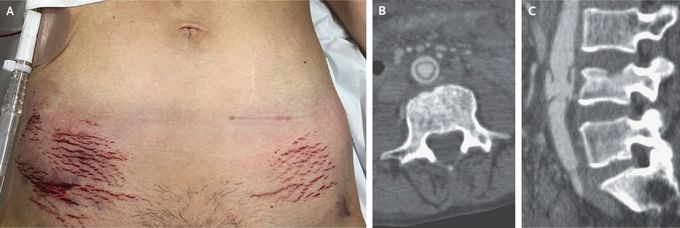


Seat-Belt Sign and Seat-Belt Aorta
A 53-year-old woman presented to the emergency department with abdominal pain after being involved in a head-on motor vehicle collision in which she had been a driver and had been wearing a seat belt. Examination revealed decreased breath sounds in the right lung field, diffuse tenderness on palpation of the abdomen, and a horizontal pattern of ecchymoses across the lower abdomen — a finding known as the “seat-belt” sign (Panel A). Computed tomographic angiography of the abdomen revealed circumferential intimal disruption of the abdominal aorta anterior to an L4 vertebral fracture (Panel B, transverse view; Panel C, sagittal view). There was no contrast extravasation, dissection, or thrombus of the aorta. A diagnosis of seat-belt aorta — a crush injury that occurs when the abdominal aorta becomes trapped between a seat belt and a vertebra — was made. Other injuries included rib and vertebral fractures, a hemopneumothorax on the right side, and an ileal perforation. No external laceration of the aorta was seen during an emergency laparotomy. Four days after the laparotomy, endovascular aortic repair was performed to mitigate the risk of lower-limb ischemia. After a prolonged hospitalization, the patient was discharged to a rehabilitation facility.

